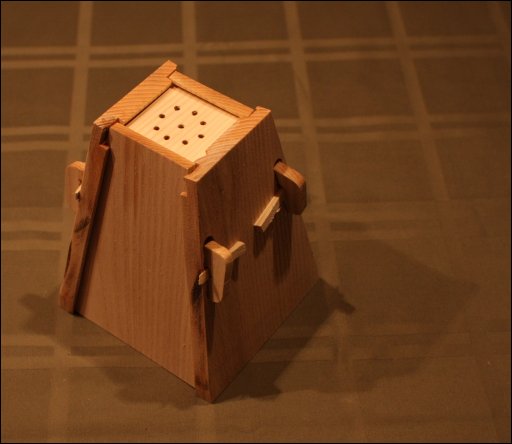I looked through my cookbook library to find something interesting and fun to make for my Easter post and found an appealing recipe in Russian Cuisine, by Lydia Lyakhovskaya. I received this book as a gift when friends traveled to Russia to adopt their daughter. I believe it was originally published in Russian and then translated to English.
 |
| ISBN 5-8194-0010-0 |
Yesterday (because this is a "make it ahead of time" dish) I put together this recipe,
Royal Paskha (page 132)
2 cups butter
5 or 6 egg yolks (I used 5)
2 cups sugar
4 cups cottage cheese
1 1/4 cups heavy (whipping) cream (I used 1 cup)
100g (3 1/2 ounces) each raisins, almonds, and candied peel
cardamom or vanilla

Rub butter with sugar until white gradually adding egg yolks one at a time. Rub paste until sugar completely dissolves, add vanilla or minced and sifted through a fine sieve cardamom for flavour. Add cottage cheese twice grated on a fine shredder, raisins, almonds, candied orange peel or grated lemon rinds. Mix thoroughly, add whipped cream and stir from top to bottom. Fill the paste into a special paskha mould over a slightly wet gauze, cover it with a saucer, press by a small weight and refrigerate for 12 hours.
My Notes
I let the butter come to room temperature. The almonds had been blanched so I chopped them and toasted them. It seemed to me that the extra nutty flavor would be a positive addition to the mix. I used 2 ounces because that is what I had.

I chose to use cardamom and decided to use 1/2 teaspoon. Also I had no candied orange peel so I used the finely shredded peel of one medium-sized lemon.
Here are the butter and sugar before they were "rubbed" together using the mixer. I was curious as to how white they would actually get!
 |
| Yes, that is one entire pound of butter. |
 |
| I thought the butter would make it yellower. |
 |
| Look at the volume in the bowl. That will change soon. |
 |
| Everything but the cream makes a full bowl. |
One note about the cream: the recipe called for heavy cream (30%) and the translation said to mix in the whipped cream. I had seen another recipe that called for the cream but did not ask for it to be whipped so I just poured it in. Besides, I didn't think my mixer's bowl could take any more volume. And that the mixture would be weighted made me think it wasn't a good idea to whip it.
I should have made a half recipe but I didn't. My goodness, it made a large quantity of paskha! I don't have a traditional paskha mould, although the other recipe I saw mentions you can use a new, clean, large ceramic flower pot. The traditional shape is a pyramid.
 |
| From: https://erik.nygren.org/category/crafts-food.html |
 |
| Mixing bowl. |
 |
| Full mould. |
 |
| Partially filled mould. |
 |
| The weight was heavy but low so it fit under the shelf. |
 |
| Rounded fluted edges |
 |
| From above |
 |
| Sharper fluted edges |
 |
| From above |
I expected it to be heavy. I expected it to be rich. I expected a sweet cheese "pudding" of sorts.
I was surprised! It was much lighter than expected, probably because of the close to 10 minutes of continuous beating with the mixer. It was rich but not overwhelmingly so. The three guest tasters all agreed it was good for a few bites and then the richness kicked in and our taste buds were satisfied. Like a good cheesecake, a little goes a long way.
The flavor was delightfully lemony. The cheese and butter provided a creamy base and the sugar made it lightly sweet. I was glad I toasted the almonds because they contributed a little umami to some of the bites. I wish I had put in more cardamom (1 teaspoon?) because I couldn't really taste it. However that might have been too much competition with the lemon. The raisins were an occasional chewy counterpoint.
The texture was grainy visually but nicely smooth to the tongue except when encountering the nuts and raisins. They kept it from being too uniform in texture.
The weighted mould's paskha seemed to have shaped to the mould better than the unweighted one. Both were thicker and drier than I had expected when I ladled the mixture into the containers the night before. I was happy to have used the cheesecloth for both as it made getting the paskha out of the mould easy. I just jiggled the cloth gently all around the edges, put the plate on top (with the cloth out to the sides), and flipped the whole thing.
I have not yet turned out the larger bowl of paskha. I think I will take it to work tomorrow and share the goodness. If I were to do this again I would make a half recipe (3 yolks) unless I knew I was feeding a crowd.
Success! Wonderfully so!
No comments:
Post a Comment